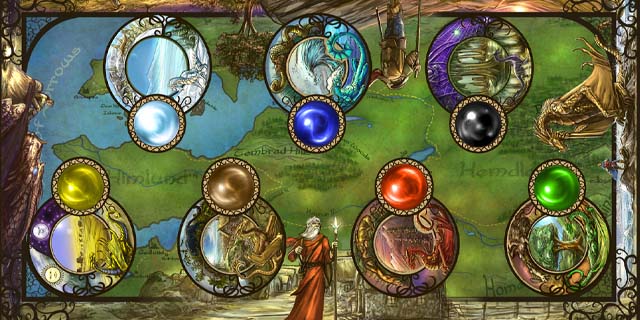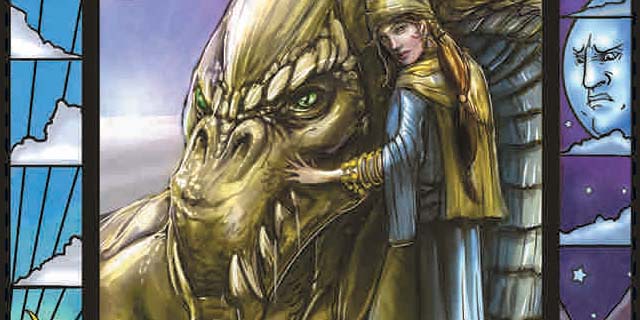
Richard Borg isn’t a name you’re going to see in this space very often, but if you’re a fan of tactical two-player war sims like Memoir ’44, Command & Colors or BattleLore (which are all basically the same system), then you are familiar with most of his notable designs. He is also credited with the classic Liar’s Dice back in 1987, so he’s been around the industry for some time. His latest non-war offering is the fantasy trick-taking card game Dragon Whisperer, which was successfully Kickstarted and published by Albino Dragon just recently.
Like most trick-taking games, Dragon Whisperer is mostly a deck of cards, this one containing seven colors with values from one through seven, plus a number of colorless Dragon Rage cards. It also features a “quest board” which will determine the point value of each quest (trick) using tokens valued at one, two, three or five points. There are seven tokens of each color that correspond both with the seven locations on the board, although two of those will be removed at random from each location before play begins, so you can never be sure what the total pool of available points will be until the very end. After players are dealt their starting hands for each round, an undealt card is turned face up to determine which color is currently “in favor” (trump).
The start player then moves the dragon token to one of the quest locations and leads with any card they wish. All other players must follow suit if possible. If they cannot follow suit, they must play a trump. Only if they possess neither can they play any other color. The exception to the above rules are the Dragon Rage cards, which can be played regardless of what else is in your hand and, since they automatically nullify the trick, allow anyone playing after them to play any color they wish. The winner of the trick usually will lead off the next quest after (optionally) moving the dragon token.

I say “usually” because Dragon Whisperer gives the lower-valued cards in each suit a useful ability to make up for the fact that they won’t be winning many tricks. The first player to play a one in a given trick will claim start player regardless of who wins, unless a Dragon Rage card is involved, as they kind of trump the ones. (Because who is going to argue with a dragon?) The first two played each trick will earn a monster token, worth one additional point at the end of the game. Finally, the first four played each trick earns a treasure token; the player with the most treasure at the end of the game earns five bonus points.
Then there are the threes. Unlike the other special abilities, threes can take effect regardless of how many have been played in that trick, since their power is to deal a new “favored” card and possibly change the trump color mid-trick! As this ability has the potential to wildly swing the outcome of a trick, the player of a three may opt to not use it. Typically this is because the favored color already matches the played three, but there could be other reasons.
Play continues until all of the quest tokens are claimed. This is normally 35 tricks (five each at seven locations), played out over five rounds with six players and (most of) six rounds with five. When playing with three or four players, it is recommended to remove two colors of cards (plus one Dragon Rage card) and all of the tokens from two locations, reducing the total number to 25. This number is a little awkward when playing with four, as eight-card hands leave one lonely token after four rounds that is probably best to just ignore rather than deal another hand for one more trick. Highest score wins, with number of quest tokens breaking ties.

As trick-taking games go, Dragon Whisperer can’t help but attract comparisons to Chronicle (especially in my group), but it has its own charms. A good deal of that charm comes from the phenomenal card art, with each color having its own images that represent the corresponding quest location’s citizenry and creatures. This game certainly looks a lot more flavorful than it actually plays, which is something of a letdown as the art could just have easily have been simple playing card symbols and it wouldn’t have made any difference. There’s a brief story in the last few pages of the rule book, but other than that nothing.
One of the advantages Dragon Whisperer has over Chronicle is length. Or, more accurately, consistent length. You know how long a session of Dragon Whisperer will last, which is typically around half an hour for the “full” game with five/six players. Chronicle‘s scoring system can make the game drag out for longer than it should or be over in as little as three rounds. The other advantage is simplicity, as Dragon Whisperer is mostly straight-forward trick-taking without the ever-changing set collection requirements and accompanying mechanics of Chronicle.
Dragon Whisperer is available for $25 from Albino Dragon’s website.



















